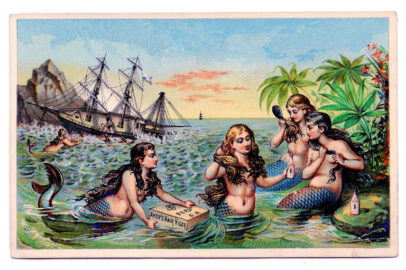
Thousands of years since the first fish goddess emerged from the primordial human collective unconscious, countless women pine to be mermaids. Hans Christian Andersen and Disney merely exploited the contents of this particular Pandora’s box. It is thought that Andersen used the archetype in order to submerge unrequited desires. Disney turned Andersen’s tortured protagonist into a powerless, lovesick girl. Both infantilized what “…has traditionally been framed as a ‘seductive and impenetrable female representative of the dark and magic underwater world from which our life comes and in which we cannot live’.” (From The Annotated Hans Christian Andersen by Maria Tatar)
Though the little mermaid and Ariel continue to strike horror into the hearts of many, they provide some with the fuel to fantasize about actually being a mermaid. (More on that later).
At Luna Station Quarterly, we’ve received plenty of mermaid stories over the years. I had one of my own published in New Fairy Tales eight years ago. My first encounter with a mermaid came via a book passed down to me by my father: The Children’s Hour, edited by Marjorie Barrows. Tom and Elizabeth Orton Jones wrote one of the tales: “Minnie the Mermaid,” first published in 1939. (Elizabeth won the 1945 Caldecott Medal for U.S. picture book illustrations).

The story of a boy named Mick who meets a young mermaid while swimming in the sea, it stood out for me mainly because of Elizabeth Orton Jones’ lovely line drawings of the impish Minnie. As a child, I was struck by Minnie’s nakedness, which both horrified and thrilled me, and her total freedom to swim alone in a vast ocean. She was spunky and had all sorts of games to play and songs to sing, while Mick tried his best to keep up.
Fish symbolize abundance, wealth, creativity, rebirth, transformation, wisdom, sincerity, and more. We may well ask: What don’t they represent? Dagon, the first human-fish chimera and deity of ancient Mesopotamia (circa 2500 BCE), is often portrayed as a fish from the waist down. He was a god of fertility: fish and grain, his purview. In that era, most depictions of human-fish hybrids were of men. The concept of fish-women seems to have burgeoned around 1000 BCE, in Assyria.
The goddess Atargatis, mother of Assyrian queen Semiramis, loved a mortal (a shepherd) and unintentionally killed him. Ashamed, she jumped into a lake and took the form of a fish, but the waters would not conceal her divine beauty. Thereafter, she took the form of a mermaid—human above the waist, fish below—although the earliest representations of Atargatis showed her as a fish with a human head and arm, similar to the Babylonian god Ea.[9] The Greeks recognized Atargatis under the name Derketo.[10] Sometime before 546 BC, Milesian philosopher Anaximander postulated that mankind had sprung from an aquatic animal species. He thought that humans, who begin life with prolonged infancy, could not have survived otherwise.
en.wikipedia.org/wiki/Mermaid#Etymology
The seas gave birth to all life on earth. In utero, the amnion holds us in its warm, oceanic embrace. Leaving it is usually the first trauma we experience. Thrust as we are into the atmosphere, where light is less filtered and our tiny lungs must cope with deadly gases, is it any wonder that deep inside some of us long for the sea?
From earliest times and throughout much of human mythology, the element of water has been viewed as feminine. Beginning with the first stories written down in Mesopotamia six thousand years ago, the primal waters were portrayed as goddesses. To the Sumerians, she was Nammu and later Tiamat, from whose body all of earthly creation was formed. Many of the major rivers of Europe and Asia are given the names of female deities.
From “The Rusalki” by Jane L. Mickelson
It may be that our connection to the sea, combined with our two-legged insufficiency to meet its demands, is what makes the mermaid archetype so powerful. Having the freedom to course vast oceans under our own strength is a tantalizing prospect for many women. In addition, despite mermaid sensuality, sex and childbirth aren’t the main aspect of their story. Well-placed seashells and glorious hair be damned, mermaids are independent, assertive, athletic, adventurous, and sociable on their own terms. They are both supremely feminine and hugely powerful. As mermaids heed their own counsel, is it any wonder so many girls and women dream of being one?
The mermaid fantasy complex is a growing industry. There are real life mermaids, books, websites, spirituality to be reclaimed. Here’s a brief sample:
I am a Mermaid: “A delicate, ladylike blog for mermaids and the humans who love them.”
(Cross-posted at Luna Station Quarterly)
- First Image courtesy of thegraphicsfairy.com
- Second Image taken by Cathrin Hagey from The Children’s Hour (Public Domain)

